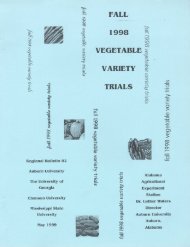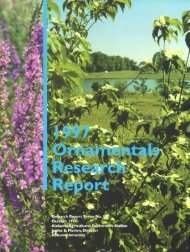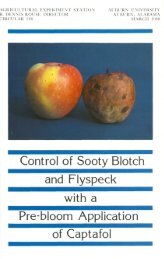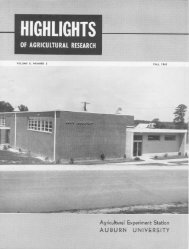MARKETING CHRISTMAS TREES - Auburn University Repository
MARKETING CHRISTMAS TREES - Auburn University Repository
MARKETING CHRISTMAS TREES - Auburn University Repository
Create successful ePaper yourself
Turn your PDF publications into a flip-book with our unique Google optimized e-Paper software.
<strong>MARKETING</strong> <strong>CHRISTMAS</strong> <strong>TREES</strong> 7<br />
TABLE 2. DISTRIBUTION OF <strong>CHRISTMAS</strong> <strong>TREES</strong> REPORTED, BY SPECIES AND BY TYPE<br />
OF SELLER, 11 SELECTED MARKETS, ALABAMA, 1956<br />
Type of seller<br />
Species Chain<br />
stores<br />
Independent<br />
grocers<br />
Civic<br />
clubs Other<br />
All types<br />
of sellers<br />
Spruce and fir 1<br />
number 8,636 1,906 14,080<br />
per cent 97.1 59.3 95.9<br />
Cedar and pine<br />
5,829 29,951<br />
26.1 63.5<br />
2---............. number 257 1,281 600<br />
per cent 2.9 39.9 4.1<br />
14,832 16,970<br />
72.7 35.9<br />
Arizona cypress2________________ number 0 25 0 244 269<br />
per cent 0 .8 0 1.2 .6<br />
Total number 8,893 3,212 14,680 20,405 47,190<br />
Distribution by type of<br />
seller_____________________________ per cent 18.9 6.8 31.1 43.2 100.0<br />
1 Largely imported varieties from northern states and Canada.<br />
2 Largely state-grown varieties or shipped in from southern Tennessee.<br />
The sample as shown in Table 2 may overemphasize the importance<br />
of civic clubs and underemphasize the chain store group in<br />
the retailing of Christmas trees in Alabama because of the inclusion<br />
in this table of two especially large selling deals by clubs.<br />
Species by Size of Cities<br />
The retailers interviewed in the small cities depended largely<br />
on imported trees, Table 3. In 3 of the 4 cities of this group, the<br />
principal sellers interviewed were chain stores that relied almost<br />
wholly on trees from the North and from Canada. Cities of the<br />
next two larger size groups apparently depended about as much<br />
on local or locally adapted trees as on imported trees. Sketchy<br />
data from the three largest cities of Alabama indicate nearly twothirds<br />
of their trees were imported. These data plus general observations<br />
indicate that the three largest cities differ sharply in<br />
the proportion of trees from distant sources. In Mobile, less than<br />
one-tenth of the trees offered were locally grown; in Montgomery,<br />
about one-fourth of the trees were locally produced; and, in Birmingham,<br />
well over half of the trees reported were either grown in<br />
Alabama or in nearby areas of Tennessee. Since relatively few<br />
chain stores were interviewed in these three cities and since such<br />
stores tend to emphasize imported trees, the proportions noted<br />
may be too high for local trees, especially in Montgomery and<br />
Birmingham. In Mobile, the other principal sellers were also importers,<br />
whereas in Montgomery and particularly in Birmingham,<br />
lot selling by many types of individuals was common.
















